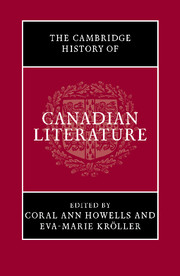Book contents
- Frontmatter
- Introduction
- PART ONE OLD AND NEW WORLD, LA NOUVELLE-FRANCE, THE CANADAS, DOMINION OF CANADA
- PART TWO THE POST-CONFEDERATION PERIOD
- 7 Post-Confederation poetry
- 8 Writing by Victorian naturalists
- 9 Short fiction
- 10 Bestselling authors, magazines, and the international market
- 11 Textual and social experiment in women’s genres
- 12 Canada and the Great War
- PART THREE MODELS OF MODERNITY, POST-FIRST WORLD WAR
- PART FOUR AESTHETIC EXPERIMENTS, 1960 AND AFTER
- PART FIVE WRITING IN FRENCH
- Bibliography
- Index
- References
9 - Short fiction
from PART TWO - THE POST-CONFEDERATION PERIOD
Published online by Cambridge University Press: 28 September 2010
- Frontmatter
- Introduction
- PART ONE OLD AND NEW WORLD, LA NOUVELLE-FRANCE, THE CANADAS, DOMINION OF CANADA
- PART TWO THE POST-CONFEDERATION PERIOD
- 7 Post-Confederation poetry
- 8 Writing by Victorian naturalists
- 9 Short fiction
- 10 Bestselling authors, magazines, and the international market
- 11 Textual and social experiment in women’s genres
- 12 Canada and the Great War
- PART THREE MODELS OF MODERNITY, POST-FIRST WORLD WAR
- PART FOUR AESTHETIC EXPERIMENTS, 1960 AND AFTER
- PART FIVE WRITING IN FRENCH
- Bibliography
- Index
- References
Summary
Two of the most eminent post-Confederation Canadian poets, Charles G. D. Roberts (1860–1943) and Duncan Campbell Scott (1862–1947), were also innovative short story writers. Of course, innovation should not be taken as the sole measure of a new country’s literary achievement, especially when its literature already exists within a larger, established tradition. But artistic invention can signal a cultural coming-of-age as well as abundant vitality, as it does for the Canadian short story in this period. Roberts’s Earth’s Enigmas: A Volume of Stories (1896) was the first of his many collections of realistic animal stories, instituting a body of work the importance of which continues to grow. And Scott’s In the Village of Viger, published the same year, was paradigmatic for the Canadian short story cycle, a genre that has continued attractive to Canadian writers. Such late nineteenth-century short stories by these and many other writers – adventurously realistic with respect to nature and adopting the practices of local color fiction – were widely praised for their convincing representations of wilderness and animals, and for their attention to linguistic and other particularities of place as small town and region. The other major short story writer of the post-Confederation period, Stephen Leacock (1869–1944), is perhaps the most internationally popular writer Canada has produced, if for a conventional kind of short story: humorous-satiric fiction.
- Type
- Chapter
- Information
- The Cambridge History of Canadian Literature , pp. 166 - 184Publisher: Cambridge University PressPrint publication year: 2009



